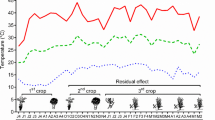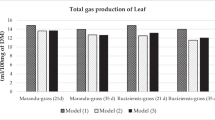Abstract
The objective of this study was to evaluate the productivity, productive efficiency, and nutritional value of the elephant grass cultivar BRS capiaçu (Pennisetum purpureum Schum.), managed at four regrowth ages during winter in the semiarid region of northern Minas Gerais, Brazil. A completely randomized design with the elephant grass cultivar BRS capiaçu was submitted to four cut intervals (30, 60, 90, and 120 days) in the winter with ten replications, for a total of 40 plots, each with a useful area of 6 × 5 m. There was a linear increase of 76.25% (P < 0.01) in the height of BRS capiaçu grass when cut from 30 to 120 days. Green matter production (P < 0.01) and dry matter production (P < 0.01) increased daily by 1081 kg/ha and 237 kg/ha, respectively. The annual dry matter production was 72 t/ha. Efficiency in water use changed (P < 0.01) from 7.91 kg of dry matter (DM)/mm at 30 days to 57.59 kg of DM/mm at 120 days of regrowth. There was a reduction in the ash content (P < 0.01), crude protein (P < 0.01), and the total digestible nutrient content (P < 0.01) with the increase in the age of the cut. The readily soluble fraction of DM (fraction A, P < 0.01), degradation rate “c” of insoluble fraction “B” (P = 0.01), potential degradability (PD; P < 0.01), and degradability (ED; P < 0.01) decreased linearly as the regrowth age increased. Harvesting is recommended at 90 days of regrowth during the winter season in this semiarid region.

Similar content being viewed by others
References
Agricultural and Food Research Council - AFRC. Energy and protein requirements of ruminants. Walligford: CAB International, 1993.
Alvalá, R.C.S.; Cunha, A.P.M.A.; Brito, S.S.B.; Seluchi, M.E.; Marengo, J.A.; Moraes, O.L.L.; Carvalho, M.O. 2019. Drought monitoring in the Brazilian Semiarid region. Annals of the Brazilian Academy of Sciences, 91: 1–15.
Association of official Analytical Chemists – International [AOAC]. 1990. Official Methods of Analysis 12ed. AOAC, Washington, DC, USA.
Casali, A. O.; Detmann, E.; Valadares Filho, S. C.; Pereira, J. C.; Cunha, M.; Detmann, K. S. C.; Paulino, M. F. 2009. Estimation of fibrous compounds contents in ruminant feeds with bags made from different textiles. Revista Brasileira de Zootecnia, 38:130-138.
Detmann, E.; Souza, M.A.; Valadares Filho, S.C.; Queiroz, A.C.; Berchielli, T.T.; Saliba, E.O.S.; Cabral, L.S.; Pina, D.S.; Ladeira, M.M.; Azevedo, J.A.G. 2012. Methods for food analysis = Métodos para análise de alimentos. Suprema, Visconde do Rio Branco, MG, Brasil (in Portuguese).
Ferreira, E.A.; Abreu, J.G.; Martinez, J.C.; Braz, T.G.S.; Ferreira, D.P. 2018. Cutting ages of elephant grass for chopped hay production. Agricultural Research in the Tropics, 48:245-253
Goering, H.K.; Van Soest, P.J. 1970. Forage fiber analysis: apparatus, reagents, procedures and some applications. Washington: USDA, 1970. 20 p.
Goes, R.H.T.B.; Patussi, R.A.; Gandra, J.R.; Branco, A.F.; Cardoso, T.J.L.; Oliveira, M.V.M.; Oliveira, R.T.; Souza, C.J.S. 2017. The crambe (Crambe abyssinica Hochst) byproducts, can be used as a source of non-degradable protein in the rumen? Bioscience Journal, 33:113-120.
Instituto Nacional de Metereologia [INMET]. (2019). Estações e Dados/Dados metereológicos. Acessado em 10 de Fevereiro de 2019 http://www.inmet.gov.br/portal/index.php?r=estacoes/estacoesAutomaticas
Jung, H.G.; Deetz, D.A. 1993. Cell wall lignification and degradability. In: Jung, H. G.; Buxton, D.R.; Hatfield, R.D.; Ralph, J. Forage cell wall structure and digestibility. Madison: American Society of Agronomy, 315-346.
Knudsen, K.E.B. 2001. The nutritional significance of “dietary fiber” analysis. Animal Feed Science and Technology, 90:3–20.
Kung Jr., L.; Shaver, R.D.; Grant, R.J.; Schmidt, R.J. 2018. Silage review: Interpretation of chemical, microbial, and organoleptic components of silages. Journal of dairy Science, 101:4020–4033
Licitra, G.; Hernandez, T.M.; Van Soest, P.J. 1996. Standardization of procedures for nitrogen fractionation of ruminant feeds. Animal Feed Science and Technology, 57:347-358.
Mapato, C.; Wanapat, M. 2018. New roughage source of Pennisetum purpureum cv. Mahasarakham utilization for ruminants feeding under global climate change. Asian-Australasian Journal of Animal Science, 31:1890-1896.
Monção, F.P.; Costa, M.A.M.S.; Rigueira, J.P.S.; Moura, M.M.A.; Rocha Júnior, V.R.; Mesquita, V.G.; Leal, D.B.; Maranhão, C.M.A.; Albuquerque, C.J.B.; Chamone, J.M.A. 2019. Yield and nutritional value of BRS Capiaçu grass at different regrowth ages. Semina Ciências Agrárias, 41:745-755
Mota, V.J.G.; Reis, S.T.; Sales, E.C.J.; Rocha Júnior, V.R.; Oliveira, F.G.; Walker, S.F.; Martins, C.E.; Cóser, A.C. 2010. Irrigation depth and nitrogen doses on elephant-grass pastures during the dry season in the north of Minas Gerais State. Revista Brasileira de Zootecnia, 39:1191-1199.
Muniz, E.B.; Mizubuti, Y.I.; Pereira, E.S.; Pimentel, P.G.; Ribeiro, E.L.A.; Pinto, A.P. 2012. Ruminal kinetics of the fibrous fraction of ruminant roughages. Revista Ciência Agronômica, 43:604-610
Neter, J.; Wasserman, W.; Kutner, M.H. 1985. Applied linear statistical models. Regression, analysis of variance, and experimental designs. 2. ed. USA, Richard D. Irwin, Inc., 1127 p.
Nocek, J. E. 1988. In situ and other methods to estimate ruminal protein and energy digestibility: a review. Journal of dairy Science, 71:2051-2069.
National Research Council - NRC. Nutrient requirements of dairy cattle, 7th rev. ed. Washington, DC: National Academy Press; 2001.
Ørskov, E.R.; McDonald, I. 1979. The estimation of degradability in the rumen form incubation measurement weighted according to rate of passage. Journal of Agricultural Science, 92:499-508.
Pereira, A.V.; Lédo, F.J.S.; Machado, J.C. 2017. BRS Kurumi and BRS Capiaçu - New elephant grass cultivars for grazing and cut-and-carry system. Crop Breeding and Applied Biotechnology, 17:59-62.
Reboita, M.S.; Rodrigues, M.; Silva, L.F.; Alves, M.A. 2015. Climate aspects in Minas Gerais state. Revista Brasileira de Climatologia, 17:206-226.
Robertson, J. B.; Van Soest, P. J. 1981. The detergent system of analysis and its application to human foods. In: James, W.P. T.; Theander, O. The analysis of dietary fiber in food. New York: Marcel Dekker, 23-158.
Sampaio, R. L.; Resende, F. D.; Reis, R. A.; Oliveira, I. M.; Custódio, L.; Fernandes, R. M.; Pazdiora, R. D.; Siqueira, G. R. 2017. The nutritional interrelationship between the growing and finishing phases in crossbred cattle raised in a tropical system. Tropical Animal Health and Production, 49:1015-1024.
Santana, P.F.; Rocha Júnior, V.R.; Ruas, J.R.M.; Monção, F.P.; Borges, L.A.; Rigueira, J.P.S.; Ramos, J.C.P.; Gomes, V.M. 2019. Feed restriction of F1 Holstein × Zebu cows in the final third of lactation modifies intake, nutrient digestibility, feeding behavior, and performance. Revista Brasileira de Zootecnia, 48:1-10.
SAS Institute., 2008. SAS/STAT 9.2 User‟s Guide. SAS Institute, Inc. Cary, NC, USA.
Sniffen, C. J.; O’Connor, J. D.; Van Soest, P. J.; Fox, D. G.; Russell, J. B. 1992. A net carbohydrate and protein system for evaluating cattle diets: II. Carbohydrate and protein availability. Journal Dairy Science, 70:3562-3577.
Van Soest, P.J. 1994. Nutritional ecology of the ruminant. 2.ed. Corvallis, O & B Books, 415p.
Velásquez, P.A.T.; Berchielli, T.T.; Reis, R.A.; Rivera, A.R.; Dian, P.H.M.; Teixeira, I.A.M.A. 2010. Chemical composition, fractionation of carbohydrates and crude protein and in vitro digestibility on tropical forages in the different cutting ages. Revista Brasileira de Zootecnia, 39:1206-1213.
Wilson, J.R. 1994. Cell wall characteristics in relation to forage digestion by ruminants: review. Journal Agriculture Science, 122:173-182.
Zailan, M.Z.; Yaaku, H.; Jusoh, S. 2016. Yield and nutritive value of four Napier (Pennisetum purpureum) cultivars at different harvesting ages. Agriculture and Biology Journal of North America, 7:213-219.
Acknowledgments
The authors thank the Foundation for Research Support of the State of Minas Gerais (FAPEMIG), National Council for Scientific and Technological Development (CNPq), the Experimental farm of Unimontes/Janaúba, EMBRAPA - Gado de Leite, and INCT - Ciência Animal.
Funding
This study was financed in part by the Coordenação de Aperfeiçoamento de Pessoal de Nível Superior - Brasil (CAPES) - Finance Code 001.
Author information
Authors and Affiliations
Corresponding author
Ethics declarations
All animal care and handling procedures were approved by the Animal Care and Use Committee of the Universidade Estadual de Montes Claros, Brazil (protocol CEBEA-Unimontes 175/2018).
Conflict of interest
The authors declare that they have no conflict of interest.
Additional information
Publisher’s note
Springer Nature remains neutral with regard to jurisdictional claims in published maps and institutional affiliations.
Rights and permissions
About this article
Cite this article
Monção, F.P., Costa, M.A.M.S., Rigueira, J.P.S. et al. Productivity and nutritional value of BRS capiaçu grass (Pennisetum purpureum) managed at four regrowth ages in a semiarid region. Trop Anim Health Prod 52, 235–241 (2020). https://doi.org/10.1007/s11250-019-02012-y
Received:
Accepted:
Published:
Issue Date:
DOI: https://doi.org/10.1007/s11250-019-02012-y




